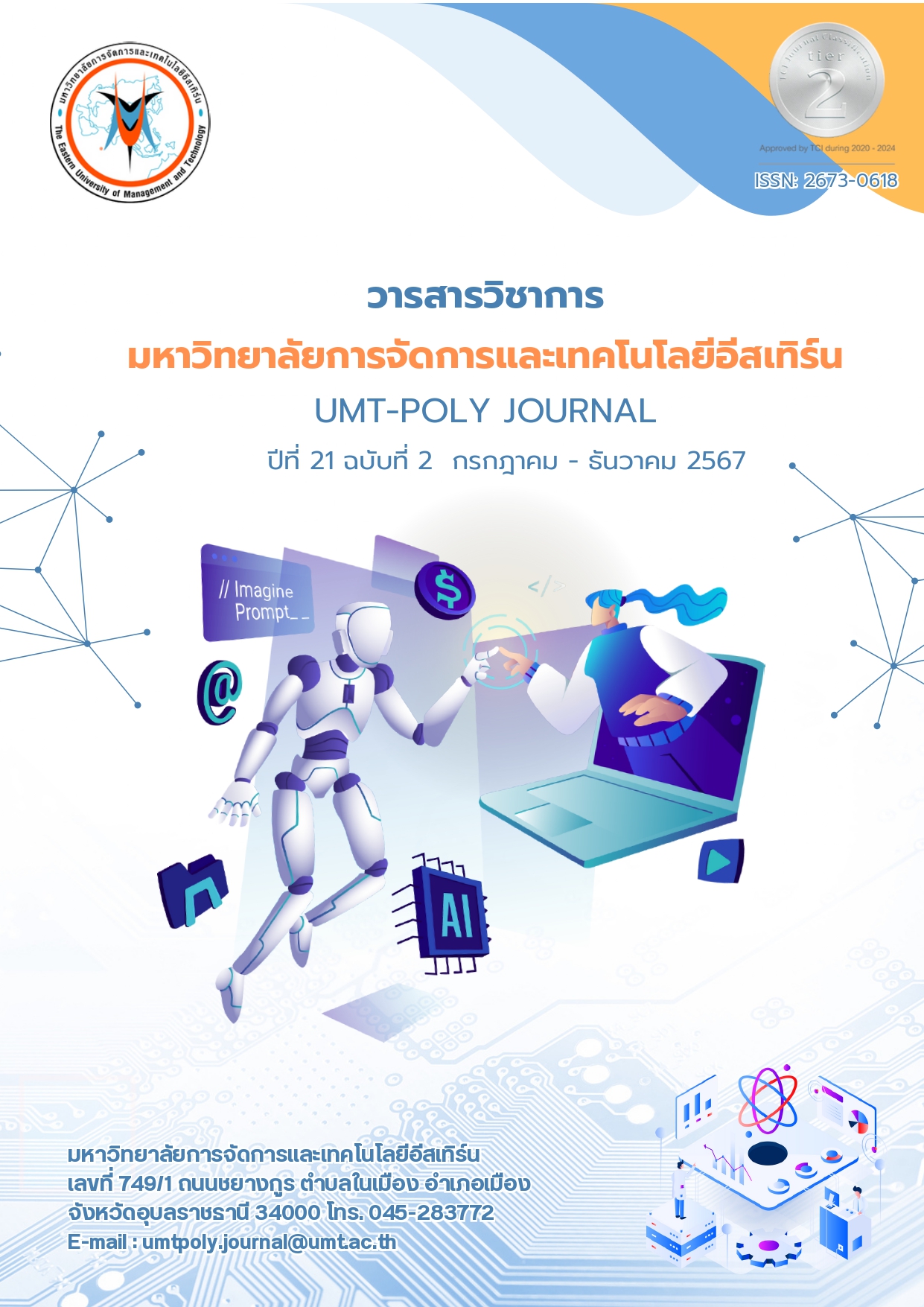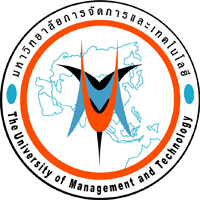The Leadership The Leadership of Female School Administrators Ubon Ratchathani Primary Educational Service Area Office 3
The Leadership of Female School Administrators Ubon Ratchathani Primary Educational Service Area Office 3
Keywords:
Leadership, Female school administratorsAbstract
Abstract
Background/ problem: Leadership of educational institution administrators was very important to educational institutions. Because lead the organization towards success. Femininity and masculinity are thus an important issue. which arises from the somewhat conflicting opinions between women and men, There are complaints about the work of school administrators that there are different management arrangements. which will affect student achievement The work of teachers and different personnel
Objective/ purpose: 1) Study the leadership of women's educational institution administrators 2) Compare the leadership of women's educational institution administrators classified by gender and work experience and size of educational institution 3) Study guidelines for leadership development of women's educational institution administrators.
Design and Methodology: Mixed methods research. Using quantitative research, questionnaires were used, with confidence in the entire version equal to 0.960 from a sample group of 287 civil servant teachers using a simple random sampling method and qualitative research Use an interview form From 5 civil servant teachers who were selected through purposive selection. Statistics used include percentage, mean, and standard deviation. T-test, f-test, and content analysis
Results: 1) The leadership of women's educational institution administrators. The overall picture is at the highest level. 2) Leadership of women's educational institution administrators When classified by gender and work experience Overall, they were significantly different at the .01 level. Classified according to the size of educational institutions, overall they were not different. And 3) guidelines for developing the leadership of women's educational institution administrators found that; (1) Initiative aspect There should be a clear operational plan. (2) Knowing how to improve and correct. Should be a refuge for government teachers and accept new ideas to improve work performance (3) Respect and acceptance There should be a meeting to plan operations and Assign work according to the abilities of the teaching staff. (4) Assistance There should be sympathy and understanding of the problems of each teacher. Have unity. (5) Persuasion. There should be friendliness towards teachers. (6) Coordination aspect should attend of the community regularly and (7) Social integration You should position yourself to be trustworthy. To be able to be accepted by subordinates and the community.
Conclusion and Implications: Leadership of women's educational institution administrators consistent with the research of Izhar Oplatka (2006), and Griffiths (1956) who studied leadership and classified it into 7 areas: initiative Knowing how to improve and fix Respect Assistance Persuasion Coordination and social integration
References
กชพรพรรณ สุทธิหิรัญพงศ์. (2562). บทบาทของผู้บริหารสถานศึกษาต่อแรงจูงใจในการปฏิบัติงานของครูและบุคลากรทางการศึกษา เขตพัฒนาพิเศษเฉพาะกิจจังหวัดชายแดนภาคใต้ 4 อำเภอของจังหวัดสงขลา. (สารนิพนธ์ศึกษาศาสตรมหาบัณฑิต). มหาวิทยาลัยหาดใหญ่.
กัลยาณี บัณฑิชาติ. (2557). ภาวะผู้นำของผู้บริหารสถานศึกษาในอำเภอเขาสมิง สังกัดสำนักงานเขตพื้นที่การศึกษาประถมศึกษาตราด. (วิทยานิพนธ์การศึกษามหาบัณฑิต). มหาวิทยาลัยบูรพา.
ขวัญทอง ฉ่าเฉื่อย และนิคม นาคอ้าย. (2559). การศึกษาความเป็นผู้นำทางวิชาการของผู้บริหารสตรีสังกัดสำนักงานเขตพื้นที่การศึกษาประถมศึกษาพิษณุโลก, ใน รายงานการประชุมวิชาการระดับชาติ มหาวิทยาลัยราชภัฏเพชรบูรณ์ ครั้งที่ 3 การวิจัยเพื่อพัฒนาท้องถิ่น. (หน้า 379). วันที่ 22 กรกฎาคม 2559 ณ มหาวิทยาลัยราชภัฏเพชรบูรณ์. เพชรบูรณ์ : มหาวิทยาลัยราชภัฏเพชรบูรณ์. 2559.
ธนนภัทร ยศดำ. (2565). ภาวะผู้นำของผู้บริหารสถานศึกษาสตรีสังกัดสำนักงานเขตพื้นที่การศึกษาประถมศึกษาสุราษฎร์ธานี เขต 3. การประชุมหาดใหญ่วิชาการระดับชาติและนานาชาติครั้งที่ 13, 2277-2293.
พสุ เดชะรินทร์. (2555). การวางแผนเชิงยุทธศาสตร์. กรุงเทพฯ : สำนักงาน ก.พ.ร. เอกสารประกอบคำบรรยาย PMQA.
ภัทรภร อุทรักษ์. (2551). ภาวะผู้นำของผู้บริหารสตรีโดยการรับรู้ ของบุคลากรในโรงเรียนสังกัดสำนักงานเขตพื้นที่การศึกษาระยอง เขต 2. (วิทยานิพนธ์การศึกษามหาบัณฑิต). มหาวิทยาลัยบูรพา.
มัชฌิมา วงษ์จันทร์เพ็ง. (2565). คุณลักษณะผู้นำของผู้บริหารสตรีในสถานศึกษาขั้นพื้นฐานในยุคดิจิทัล. วารสารบริหารการศึกษาบัวบัณฑิต, 21(2), 11-18.
สักรินทร์ ทองศรี. (2557). ภาวะผู้นำของผู้บริหารสถานศึกษาสตรีในโรงเรียนสังกัดสำนักงานพื้นที่การศึกษาประถมศึกษาบุรีรัมย์ เขต 2. (วิทยานิพนธ์ครุศาสตรมหาบัณฑิต). มหาวิทยาลัยราชภัฏบุรีรัมย์.
สาธิต มณฑาณี. (2559). พฤติกรรมภาวะผู้นำของผู้บริหารสตรีในทัศนะของครูโรงเรียนมัธยมศึกษาจังหวัดปทุมธานี สังกัดสำนักงานเขตพื้นที่การศึกษามัธยมศึกษา เขต 4. (วิทยานิพนธ์การศึกษามหาบัณฑิต). มหาวิทยาลัยบูรพา.
สิริพรรณ ชูสกุล. (2562). ความสัมพันธ์ระหว่างภาวะผู้นำทางวิชาการของผู้บริหารสถานศึกษากับการเป็นชุมชนแห่งการเรียนรู้ทางวิชาชีพของโรงเรียนบนพื้นที่สูง สังกัดสำนักงานเขตพื้นที่การศึกษาประถมศึกษาเชียงราย เขต 3. (วิทยานิพนธ์ ปริญญาการศึกษามหาบัณฑิต). มหาวิทยาลัยพะเยา.
สุวิมล โตปิ่นใจ. (2556). ภาวะผู้นำของผู้บริหารโรงเรียนกลุ่มบางบ่อ 2 อำเภอบางบ่อ จังหวัดสมุทรปราการสังกัดสำนักงานเขตพื้นที่การศึกษาประถมศึกษาสมุทรปราการ เขต 2. (วิทยานิพนธ์การศึกษามหาบัณฑิต). มหาวิทยาลัยบูรพา.



